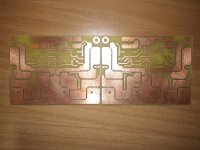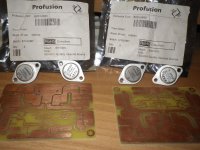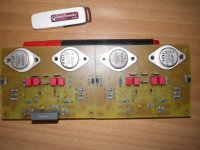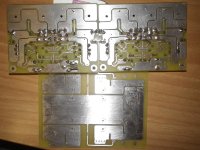Cheap chassis for VSSA PeeCeeBee project
The cheapest option for diy-er is to go to the nearest metalworks company willing to serve individual buyers. One such company is located at 30 minutes walking distance from my home.
Box consist of three pieces:
All pieces are cut by guillotine method and bent at hydraulic press. Company in my home town has waterjet and laser CNC machines but it is too expensive for me to use it for cutting holes. Also, they usually ask for AutoCAD drawings and I do not have AutoCAD on my PC. Therefore all holes are made using drill, files and sandpaper. I use three box sizes: S(mall), M(edium) and L(arge). The box shown is M, roomy enough for preamps and small chip amp based power amps with toroidal transformers up to 200VA. M and L box are in standard 430mm width, and S is half of it.
S box cost me around USD15.- L box is around USD25.-
The cheapest option for diy-er is to go to the nearest metalworks company willing to serve individual buyers. One such company is located at 30 minutes walking distance from my home.
Box consist of three pieces:
- Chassis 3mm aluminium (very stable!)
- Cover 2mm aluminium
- Front plate 5mm aluminium
All pieces are cut by guillotine method and bent at hydraulic press. Company in my home town has waterjet and laser CNC machines but it is too expensive for me to use it for cutting holes. Also, they usually ask for AutoCAD drawings and I do not have AutoCAD on my PC. Therefore all holes are made using drill, files and sandpaper. I use three box sizes: S(mall), M(edium) and L(arge). The box shown is M, roomy enough for preamps and small chip amp based power amps with toroidal transformers up to 200VA. M and L box are in standard 430mm width, and S is half of it.
S box cost me around USD15.- L box is around USD25.-
Attachments
I don't think these will make a big difference in the sound. Not as much as the main filter caps, and not nearly as much as the input series capacitor.I need help choosing the 1uF bypass capacitors...
Hi Paulo,
I have used a 1µF capacitor made by NSF, as it isn't very important, and Panasonic FM's for input and output sections, and FC for the larger Vas stage requirement. The ones on the output stage are 2 x 680µF per rail, because that is what I could find for the money. But where it is (in the circuit and on the board) is as important as the quality, IMHO.
I also use Nichicon caps for the output and Vas power supplies (8,800 µF per rail), as I have three different power supplies per board, ±12v for input, ±42v for Vas and ±35 v for output section, and I am making 4 amplifiers.
I have used a 1µF capacitor made by NSF, as it isn't very important, and Panasonic FM's for input and output sections, and FC for the larger Vas stage requirement. The ones on the output stage are 2 x 680µF per rail, because that is what I could find for the money. But where it is (in the circuit and on the board) is as important as the quality, IMHO.
I also use Nichicon caps for the output and Vas power supplies (8,800 µF per rail), as I have three different power supplies per board, ±12v for input, ±42v for Vas and ±35 v for output section, and I am making 4 amplifiers.
Last edited:
Unfortunately, there is no single best choice.Now for the electros: between Nichicon KA and Panasonic FC/FM wich ones should I use?
Your personal preference will be more important than any advice you get.
There will not be one SINGLE type of capacitor that will be best in all places in the circuit, or one type that will satisfy all people building the same circuit. Even today, no single device will have ALL the best possible characteristics.
Since I know you have a pair of my boards, I would say this:
In general (if you are building the board with 6 caps), select low ESR high ripple types for the capacitor closest to the output (power) transistors. Select audio grade caps closest to the input and VAS stages (low ESR or low impedance will also work here, obviously). See pic below.
If you are building the version exactly according to Shaan's circuit (with 4 caps), then you have to rely on the specs of the power supply "reservoir" caps for the power stage, and select the other 4 caps according to whatever is important to you.
Here is a link to a simple article about low ESR and low impedance (low Z), with no audiophool jargon:
http://www.illinoiscapacitor.com/pdf/Papers/low_ESR_fact_or_fiction.pdf
Attachments
Unfortunately, there is no single best choice.
Your personal preference will be more important than any advice you get.
There will not be one SINGLE type of capacitor that will be best in all places in the circuit, or one type that will satisfy all people building the same circuit. Even today, no single device will have ALL the best possible characteristics.
Since I know you have a pair of my boards, I would say this:
In general (if you are building the board with 6 caps), select low ESR high ripple types for the capacitor closest to the output (power) transistors. Select audio grade caps closest to the input and VAS stages (low ESR or low impedance will also work here, obviously). See pic below.
If you are building the version exactly according to Shaan's circuit (with 4 caps), then you have to rely on the specs of the power supply "reservoir" caps for the power stage, and select the other 4 caps according to whatever is important to you.
Here is a link to a simple article about low ESR and low impedance (low Z), with no audiophool jargon:
http://www.illinoiscapacitor.com/pdf/Papers/low_ESR_fact_or_fiction.pdf
Good advice, PMI, thank you!
Main advantage of KA series may be the wider temp range (up to 105C). If the inside of your amp ever gets that hot...Anyway, I've never listened to a KA before, only Fine Gold, KZ and FW. Does anyone know how they are soundwise compared with lets say FG?
Some progress!!
Nice!
I'll be curious to get your impressions with those Exicon's and the BC series transistors. I'm sure the input transistors I used on my pair (the Japanese version) and the old Hitachi outputs likely aren't quite as good and I'm still blown away by the sound.
Six transistors had no right to sound this good!
Some progress!!
Nice!
Do you have any surplus?
Regards zeoN_Rider
Nice!
I'm still blown away by the sound.
Six transistors had no right to sound this good!
True about six transistors only, elsewhere, but you have know that these are connected in a magic circuit. No room for an error.

2nd that!...still blown away by the sound...

I am not very fond of audiophile jargon, but the best description I can think of is that the sound reproduction seems very accurate, even with modest speakers, without giving up any musical quality.
Also, if there is any magic here, it is surely in the circuit design, because my first set of boards was built with very conventional components.
Kudos to Lazy Cat and Shaan for making this possible for the rest of us!
Nice!
Do you have any surplus?
Regards zeoN_Rider
Hi ZeoN_Rider
I had bought a total of 16 pieces for my Golmund Clone amplifier. I used twelve in amplifier and I stayed with two couples for VSSA amp.
I had ordered from the PROFUSION and pay them by bank transfer.
Regards Nikos
- Home
- Amplifiers
- Solid State
- PeeCeeBee
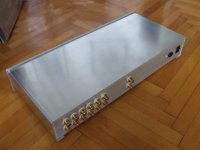
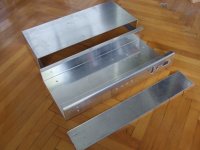
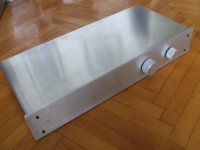
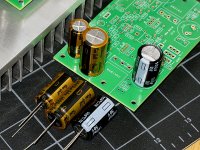
 Sounds interesting... any pics yet?
Sounds interesting... any pics yet?